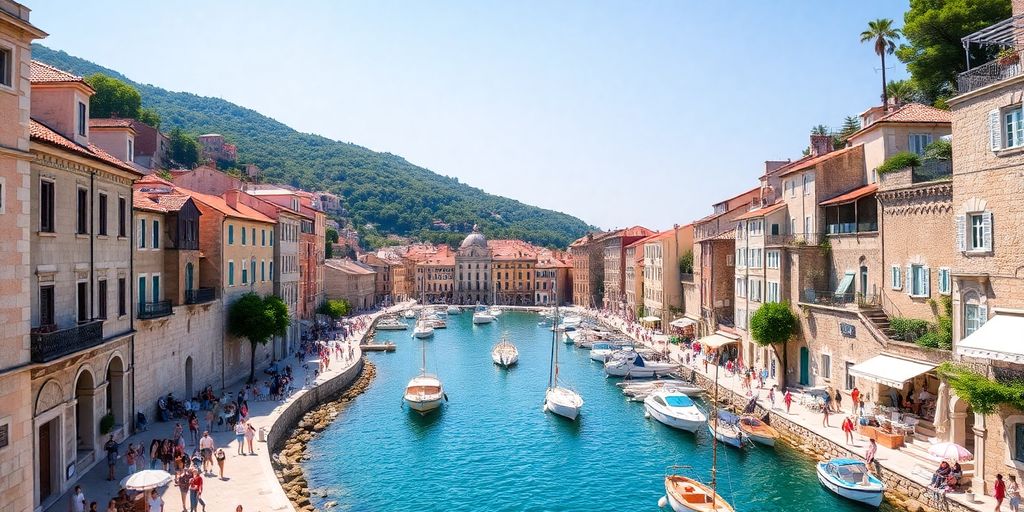Croatia’s tourism sector is experiencing a significant boom in early 2025, with double-digit growth in arrivals and overnight stays. This surge, part of a broader European trend, is fueled by increased demand, expanded air connectivity, and strategic tourism initiatives. However, this rapid growth also brings challenges, particularly overtourism in popular regions like Istria, prompting authorities to implement sustainable practices.
Croatia’s Tourism Soars
Croatia has emerged as a leading destination in Europe’s tourism revival, reporting remarkable growth in April 2025. The Croatian Bureau of Statistics data shows a 14.8% increase in arrivals and an 18.4% increase in overnight stays compared to the previous year. Foreign tourists accounted for 85.5% of all overnight stays, with German visitors leading the way, contributing 18.9% of foreign overnight stays.
- Key Growth Indicators (April 2025):
- Total Tourist Arrivals: 1.2 million (+14.8%)
- Total Overnight Stays: 3.3 million (+18.4%)
- Foreign Tourist Overnight Stays: 2.8 million (+21.6%)
- Domestic Tourist Overnight Stays: 477,000 (+2.6%)
Istria remained the most visited region, recording 997,000 overnight stays, a 30.2% increase from April 2024. This positive trend extends to the first four months of 2025, with a 3.6% rise in arrivals and a 4.7% increase in overnight stays compared to the same period in 2024.
Drivers of Growth
The surge in Croatian tourism is attributed to several factors:
- Expanded Air Connectivity: New and increased flight routes from major European cities, including Seoul, Toronto, and various European hubs, have made Croatia more accessible.
- Post-Pandemic Travel Reforms: Strategic efforts to simplify entry rules and promote off-season travel have broadened Croatia’s appeal.
- Increased Demand: A general resurgence in European travel, driven by pent-up wanderlust and flexible work arrangements, has led to more travelers seeking authentic cultural experiences and natural landscapes.
The Challenge of Overtourism
While celebrating record visitor numbers, Croatia faces the growing challenge of overtourism, particularly in high-density regions like the Istrian peninsula. In 2023, Istria reported approximately 133 overnight stays per resident, leading to:
- Overcrowding
- Strain on local infrastructure
- Rising housing costs
- Concerns about the livability of host communities
Sustainable Tourism Initiatives
In response to these pressures, Croatian authorities are shifting focus from volume-based tourism to sustainable strategies. Measures include:
- Promoting travel to lesser-known inland regions and smaller islands to disperse crowds.
- Marketing campaigns highlighting off-peak months for cultural and outdoor tourism.
- Implementing initiatives to regulate short-term vacation rentals to balance housing markets.
- Encouraging eco-friendly accommodations and green transport options.
- Introducing capacity limits and reservation systems in national parks and protected areas.
Croatia’s approach aims to balance economic growth with environmental preservation and the quality of life for local residents, setting a blueprint for sustainable tourism in the post-pandemic era.
Sources:
- Croatia Joins Spain, Italy, Iceland, Malta, Latvia, Finland and Bosnia in Driving European Tourism Boom With
Double-Digit Growth This April, Travel And Tour World. - Croatian tourism soars in April with double-digit growth in arrivals, Croatia Week.
- Foreign tourist arrivals to Croatia up 2.4% y/y in Jan-Apr | Croatia Economy News, SeeNews.
- Croatia’s Tourism Soars: Early 2025 Records Shattered | Latest Balkan and Southeast European News, Independent Balkan News Agency.
- Croatia’s Expanding Air Connectivity And Post-Pandemic Travel Reforms Spark Record Visitor Arrivals In 2025
While Authorities Tackle The Pressures Of Overtourism In Popular Regions, Travel And Tour World.






